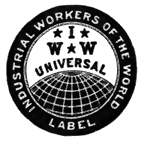Agribusiness and the State
Three items:
1) Via Stanley Dagnal Rowe, Jr. A great article by Joel Salatin of Polyface Farm: "Everything I Want to Do is Illegal."
This doesn't fall under the heading of regulatory restrictions on small-scale agriculture, but it deals with another theme I've touched on: raising the threshold of subsistence by crowding out or prohibiting the means of comfortable poverty.
2) Via Steve Bryant, by email. An interesting review at Monthly Review of The Conquest of Bread, by Richard A. Walker (a history of agribusiness in California):
3) at Counterpunch, "Corporate Agriculture's Dirty Little Secret," by Al Krebs:
1) Via Stanley Dagnal Rowe, Jr. A great article by Joel Salatin of Polyface Farm: "Everything I Want to Do is Illegal."
I want to dress my beef and pork on the farm where I’ve coddled and raised it. But zoning laws prohibit slaughterhouses on agricultural land. For crying out loud, what makes more holistic sense than to put abattoirs where the animals are? But no, in the wisdom of Western disconnected thinking, abattoirs are massivecentralized facilities visited daily by a steady stream of tractor trailers and illegal alien workers.
But what about dressing a couple of animals a year in the backyard? How can that be compared to a ConAgra or Tyson facility? In the eyes of the government, the two are one and the same. Every T-bone steak has to be wrapped in a half-million dollar facility so that it can be sold to your neighbor. The fact that I can do it on my own farm more cleanly, more responsibly, more humanely, more efficiently, and in a more environmentally friendly manner doesn’t matter to the government agents who walk around with big badges on their jackets and wheelbarrow-sized regulations tucked under their arms.
OK, so I take my animals and load them onto a trailer for the first time in their life to send them up the already clogged interstate to the abattoir to await their appointed hour with a shed full of animals of dubious extraction. They are dressed by people wearing long coats with deep pockets with whom I cannot even communicate. The carcasses hang in a cooler alongside others that were not similarly cared for in life. After the animals are processed, I return to the facility hoping to retrieve my meat. When I return home to sell these delectable packages, the county zoning ordinance says that this is a manufactured product because it exited the farm and was reimported as a valueadded product, thereby throwing our farm into the Wal-Mart category, another prohibition in agricultural areas. Just so you understand this, remember that an onfarm abattoir was illegal, so I took the animals to a legal abattoir, but now the selling of said products in an on-farm store is illegal....
What does the Organic Trade Association have to fear from me using the “O” word?
If society really wants government certification, my little market share will continue to deteriorate into oblivion. If, however, the certification effort represents a same-old, same-old power grab by the elitists to exterminate the fringe players, it is merely another example of fear replacing faith.
This doesn't fall under the heading of regulatory restrictions on small-scale agriculture, but it deals with another theme I've touched on: raising the threshold of subsistence by crowding out or prohibiting the means of comfortable poverty.
You would think that if I cut the trees, mill the logs into lumber, and build the house on my own farm, I could make it however I wanted to. Think again. It’s illegal to build a house less than 900 square feet. Period. Doesn’t matter if I’m a hermit or the father of 20. The government agents have decreed, in their egocentric wisdom, that no human can live in anything less than 900 square feet.
Our son got married last year and wanted to build a small cottage on the farm, which he now oversees for the most part. Our new saying is, “He runs the farm, and I just run around.” The plan was to do what Mom and Dad did for Teresa and I — trade houses when children come. That way our empty nest downsizes, and the young people can upsize in the main family farmhouse. Sounds reasonable and environmentally sensitive to me. But no, his little honeymoon cottage — or our retirement shack — had to be a 900-square-foot TajMahal. A state-of-the-art accredited composting toilet to avoid the need for a septic system and sewer leach field was denied.
2) Via Steve Bryant, by email. An interesting review at Monthly Review of The Conquest of Bread, by Richard A. Walker (a history of agribusiness in California):
Popular wisdom has it that the success of agriculture in California springs from the natural abundance of the state’s Mediterranean climate and alluvial soils. But an argument made popular by Marc Reisner, in Cadillac Desert, and menacing in Roman Polanski’s film noir Chinatown, holds that the motor behind California’s growth has been the massive federal and state water projects that have diverted millions of gallons of water to irrigate the fields of California’s farmers. The munificence of nature and bounteous irrigation have undoubtedly ratcheted up the level of dynamism of California’s agriculture, contends Walker, but neither has been the catalyst for it. Water in particular lacks explanatory power as the driving force behind the state’s double-edged vitality since irrigation projects were not in the forward guard of the growth of California agriculture, but trailed behind it.
Agrarian capitalism and the dynamism of the region, Walker argues, have been undergirded by the twin commodification of land and labor—that is, the transformation of nature and human activity into objects that could be bought and sold on the market. Following California’s annexation by the United States, Gold Rush–engorged speculators grabbed large tracts of the countryside, by expelling Native American tribes from their land, snapping up property from Mexican rancheros, and benefiting from the largesse of the privatization of federal lands. Within a generation, land could be exchanged on the market without constraint.
Labor in California was turned into a commodity through a process which Marx, borrowing from Adam Smith, termed “primitive accumulation.” American Indians who had been peons or hunter gatherers were now turned into “free” wage workers to toil on the farms of California’s new capitalists. Toward the end of the nineteenth century, California moved from production of grains, garden crops, and cattle grazing, to a revolution in horticulture, growing a plethora of oranges, lemons, apricots, almonds, and figs. Large numbers of workers were needed in the orchards at harvest time and recruiters rounded up U.S.-born and immigrant workers, poor town dwellers and footloose fruit tramps, in order to ensure a glut of labor and pittance wages.
The dawn of wage labor did not preclude growers from harnessing unfree labor under fully capitalist conditions, as with the notorious bracero program. An arrangement put in place during the Second World War, the bracero program institutionalized a form of indentured labor in which more than four million Mexicans were brought to the United States to work as farm laborers stripped of the freedom to leave employers. It was eventually abolished in 1964, after having lowered farm wages and given capital accumulation a large shot in the arm, but it illustrated the very active role of the state as a handmaiden of the interests of agrarian capitalists in procuring cheap, yoked labor.
Walker maintains that the process of “primitive accumulation” is not a one-off phenomenon in the transformation of pre-capitalist social relations to full-blown capitalism, but rather a continuous process that partially accounts for the weakness of the labor movement in California. Growers and processors have depended on successive waves of dispossessed or foreign workers—Native Americans, Basques, Chinese, Japanese, Italians, Portuguese, Mexicans, Punjabis, Mixtecans, Hmong, and Vietnamese—many of whom are later deported and replaced by new immigrants. Such a strategy undermines the ability of workers to build alliances and unify themselves as a conscious class....
As Walker makes clear, in its one hundred and fifty year history, California never was the domain of family farmers, but instead was characterized by large landholdings from the time of the Gold Rush.
3) at Counterpunch, "Corporate Agriculture's Dirty Little Secret," by Al Krebs:
To begin with the question needs to be asked who really are "illegal" immigrants on mostly territory that now comprises one third of the U.S. land mass and which in fact belonged to Mexico prior to the Treaty of Guadalupe Hidalgo of 1848 ?
Here was land literally stolen from the Mexican people by a handful of thievish land barons in what the famous land reformer Henry George once described as "a history of greed, of perjury, of corruption, of spoliation and high-handed robbery for which it would be difficult to find a parallel."
The long-term consequences of such action was that in the words of Ernesto Galarza, author of the classic Merchants of Labor, the Treaty left "the toilers on one side of the border, the capital and the best land on the other."
Therefore, it is no accident that throughout U.S. history the chronic areas of rural poverty have remained the South, where the plantation system has dominated the agricultural scene, and the Southwest, where the vast tracts of productive land have remained in the hands of a privileged few through the years.
During those years these large growers have developed the mistaken notion that the nation and our government should provide them with a cheap, unorganized work force.
With such initiatives as the bracero program, originally passed by the Congress during World World II as an emergency manpower act and which remained in place until 1964 before it was terminated, and in recent years so-called "guest worker" programs, corporate agribusiness has managed to hoodwink politicians and the public into thinking that unless these programs were continued our crops would rot in the fields.
This same thinking also motivated the large meat and poultry slaughter houses in the Midwest beginning in the late 1960's, to aggressively and promote the idea that they too should be entitled to the "the slaves we rent."









6 Comments:
Salatin's article has so much explanatory power, it's amazing. This is the essential pattern of everything that's wrong with big government.
Another place where this distortion can be seen is in the making of chicken as an everyday meat whereas eating rabbit is just killing the easter bunny. Yet ag costs of chickens are dampened by the economies of scale whereas rabbits need to be slaughtered in staiunless steel kitchen with inspection that costs more than the production cost of the meet. Plus most USDA inspectors are not certed in rabbit - and most abbatoires will not let you use their space nor their inspectors for prepping the carcass. So you cant eat bunny, just mass-produced fowl.
mmm - dahtah lemme cn spel. and what would merica do if tyson went under like enron?
Thanks for the info, Dr. Lenny. I never tried to raise rabbits for commercial sale, so I didn't know the regulatory disabilities imposed on them. It's a shame, because rabbit is a pretty cheap source of protein.
I think readers of this thread will find this recent counterpunch article interesting.
On the rabbit issue, Australians have a different cultural view of rabbits; wild rabbits are a pest. Unfortunately wild rabbits are no longer a convenient cheap meat, since they are deliberately diseased for biological control these days.
On the small scale, guinea pigs are actually convenient to raise for meat in smallholdings - if you don't get the same cultural reservations. I doubt if they give the same problem as rabbits, of "rabbit starvation".
Rabbit meat is so lean that a rabbit-only diet is liable to cause dietary deficiency from insufficient fat and fat-soluble vitamins. The trick to beat this is to put their brains into the stew pot - nerve tissue needs a lot of associated fat to work.
For now I'm still putting my old page reference in my link until I find where my ISP has moved everything to this time.
You should be able to use google's cache of my publications page to be going on with.
As a breeder and eater of my own livestock I agree that agribusiness is evil. The soils that they use to mass produce our food are leached of its nutirents and only produce due to tons of chemical fertilizers that are now leaching into the ground water.
go to www.themeatrix.com to see how bad it really is.
And just from my own based opinion, the majority of the southwest is wasted on cattle - one of the main problems with the southwest is that the cattle over graze and screw up the ecology - this is actually prime goat country, but americans are too prissy to see it.
Post a Comment
<< Home